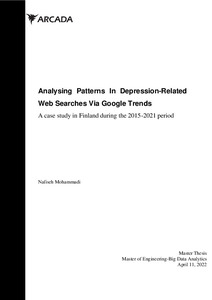Analysing Patterns In Depression-Related Web Searches Via Google Trends A case study in Finland during the 2015-2021 period
Mohammadi, Nafiseh (2022)
Mohammadi, Nafiseh
2022
All rights reserved. This publication is copyrighted. You may download, display and print it for Your own personal use. Commercial use is prohibited.
Julkaisun pysyvä osoite on
https://urn.fi/URN:NBN:fi:amk-2022060114058
https://urn.fi/URN:NBN:fi:amk-2022060114058
Tiivistelmä
Considering high level of internet usage in Finland and popularity of Google Search Engine, in this research, we scrape Google Trend time series data for six years from 2015 to 2021 for depression-related-terms in Finland geographical area. The terms are 36 top related words to “Masennus”, Finnish word for depression, and” Depression” introduced by Google Trend. To find different categories of the search-terms which bear similar trend in time, we applied supervised machine learning method, clustering. Comparing results of three different popular clustering methods, agglomerative clustering method with two number of clusters produces the most proper categories. 12 terms which fall into a same cluster as of “Masennus” in this clustering method are selected for analyses of temporal rhythms. Some of the temporal rhythms are as follow; Search volumes for all depression related terms follow a similar diurnal pattern. Late hours of nighttime 23,24 and 1 o’clock are peaks for search of the terms. Nighttime, 8 p.m. to 7 a.m., have 60% versus 40% in comparison to daytime, 7 a.m. to 8 p.m. For 5 years of 2015 to 2019, during winter months, four months from November to February, interest to search the selected terms is more than other months. In 2020, there is a sharp decline in the volume of the search-terms in March and February in comparison to other years. Categorizing the search volume based on day of week, the highest search tends to be conducted on Mondays while the lowest is on Saturdays and Fridays. However, Sunday nights from 7 a.m-7p.m. tends to have the highest volume of searches among the rest nights of a week. Temporal pattern in volume of the search terms reflects rhythm of the depressive mood and is a helpful tool for wiser allocation of resources and timely response to the need of public.
